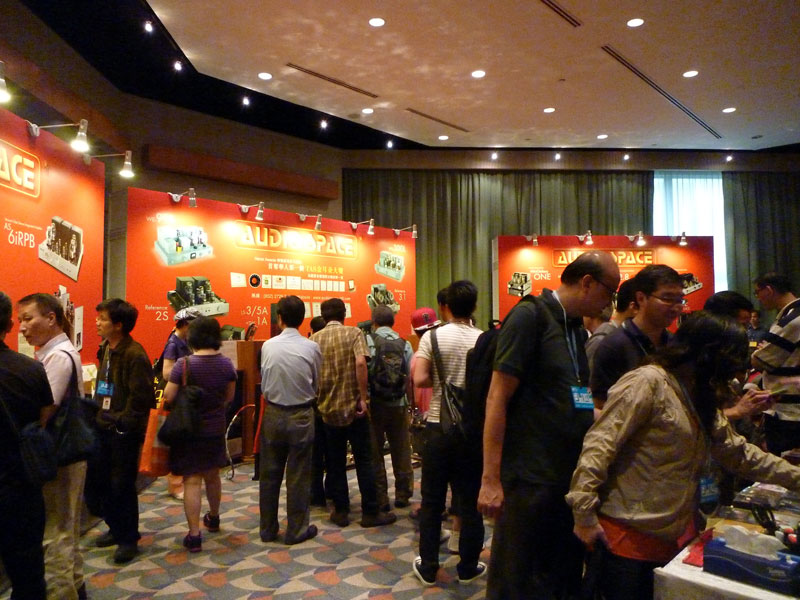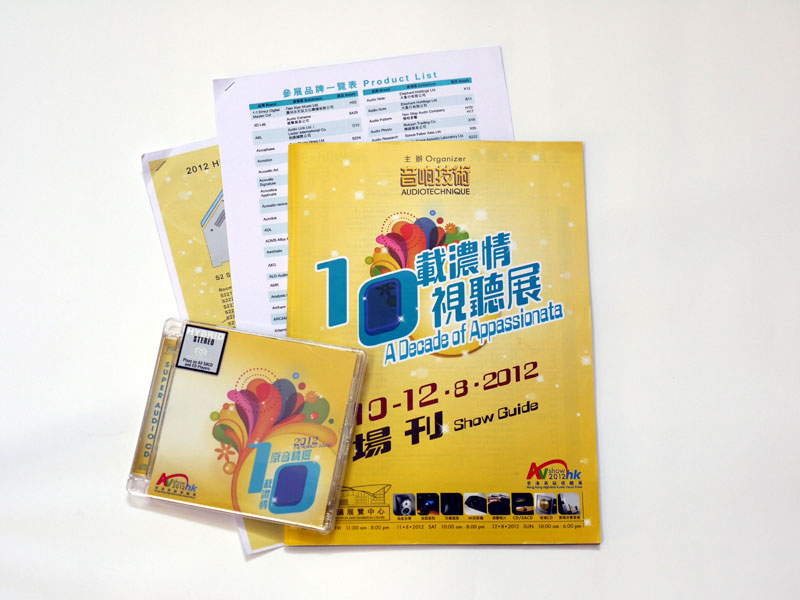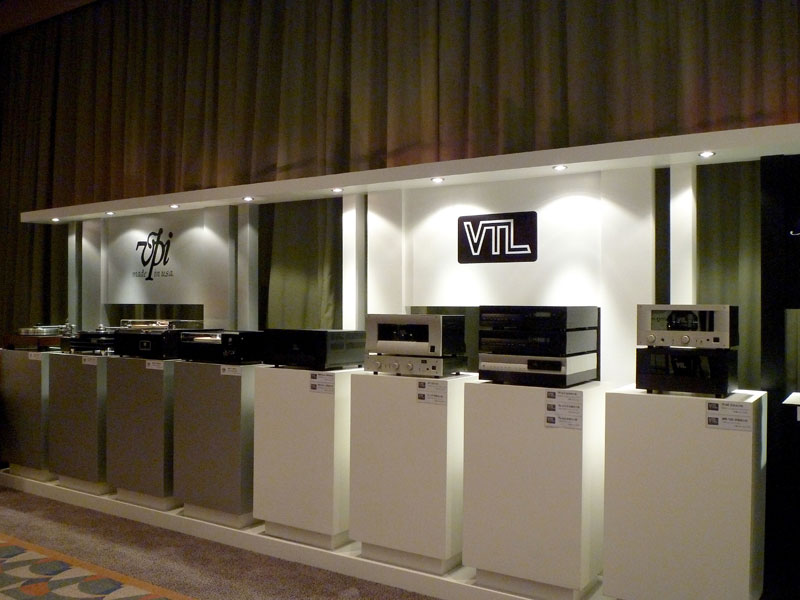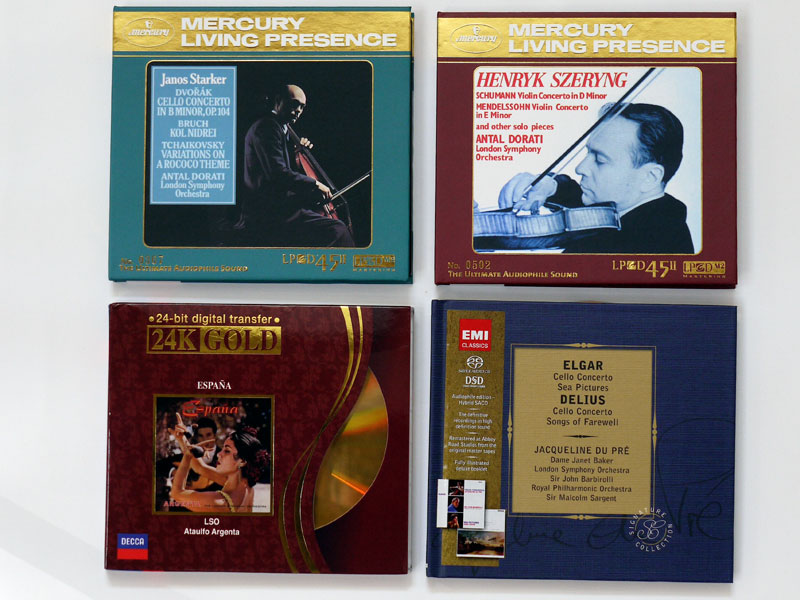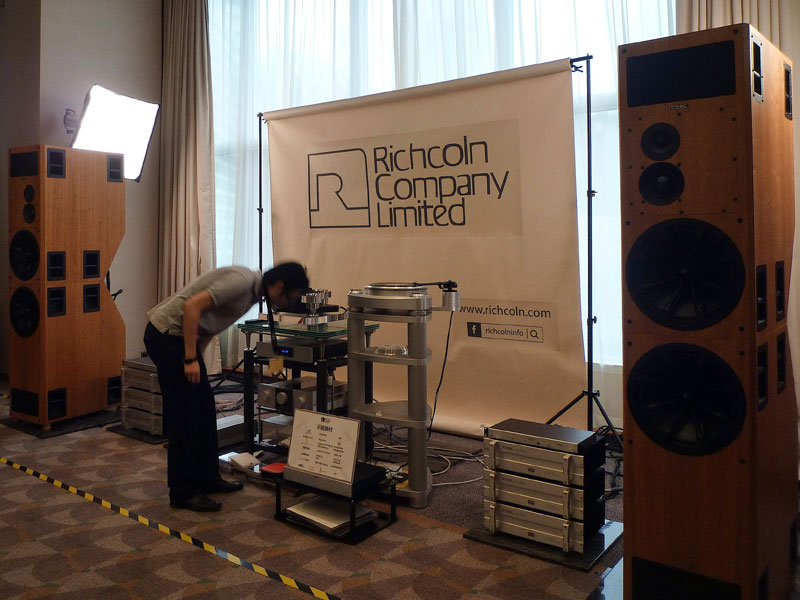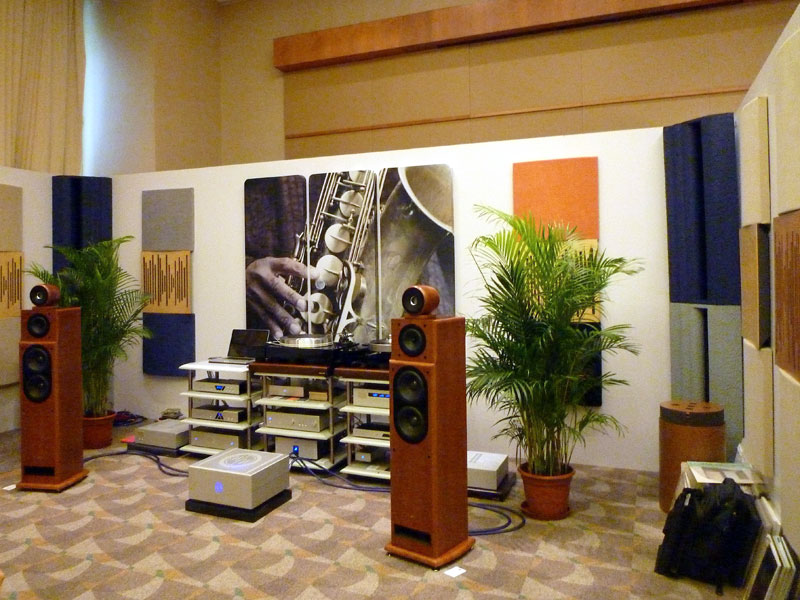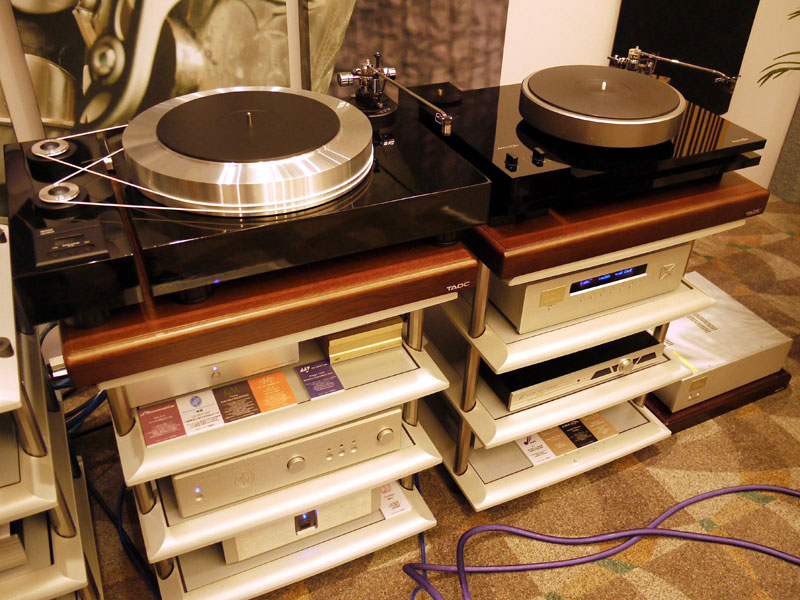Hong Kong Audio Visual Show 2012 • If You Hold It, They Will Come by Roy Gregory | August 25, 2012Hi-fi shows come in many shapes and all sizes, from a one-off evening event at a local dealer to the massive, mainstream electronics-industry sprawl of CES. You can classify these shows in any one of a number of ways, from the exhibitor profile to the exhibitor numbers, the quality of the visitors or their quantity. The one factor that show organizers seem to cling to is the most basic gauge of all: footfall -- despite the fact that by this measure, most Anglophone shows are failing miserably. These days, quality-orientated consumer events are becoming increasingly bijou: the excellent Rocky Mountain Audio Fest attracts an impressive array of exhibitors, but visitors number a few thousand, while in the UK the National Audio Show is lucky to scrape much beyond the four-figure barrier. Contrast that with the Hong Kong High End Audio Visual Show with 26,000 visitors spread across its three days -- and that’s down slightly on last year. It is also almost twice the number attracted by the four-day Munich show, the biggest and most important event in Europe. The queues before opening on the first day were so long that the Convention and Exhibition Centre, where the show is held, had to open an empty hall just to accommodate the snaking throng of people.
A number of factors feed into this success: the show is (superbly) organized by Audio Technique, the most important magazine in the Chinese-speaking market -- rapidly becoming the most vibrant and important market in the audio world; for their $80 HK entry fee (a shade over 10 US bucks), each visitor receives not just a show guide but a hybrid CD/SACD sampler of demonstration-quality tracks chosen by magazine editor Lincoln Cheng from music reviewed or discovered over the course of the preceding year; the event offers everything from bargain-basement tweakery through to the highest of high-end equipment; the people of Hong Kong seem to have an insatiable fascination with things audio -- not to mention a sharp eye on economic opportunity (apparently, the show sampler discs fetch a serious premium online).
Whichever way you slice it, the Hong Kong Show is fast becoming one of the events in the audio calendar, attracting more and more high-profile product launches and increasing overseas attention, from manufacturers and the press alike. A show with a difference Every show has its own character, its own strengths -- and its own weaknesses (some more than others) -- and Hong Kong is no different. You will never mistake this show for any other -- partly because of the venue, partly because of the way it is organized and mostly because of the way it happens. The Hong Kong Convention and Exhibition Centre is a stunning venue in a stunning location. Its futuristically curved and interlocking carapace might look like something out of science fiction, but its clean, modern interior and spacious facilities are key to the show’s success. Although this is a purpose-built exhibition space -- like the beautiful but sonically disastrous M.O.C. in Munich -- it offers massive halls alongside separate meeting rooms, which offer the discrete spaces and opportunity for high-end systems to actually perform. It even offers a whole array of dining options, space to relax and clear signage, which in conjunction with the excellent show guide (in Chinese but with an English précis and product index) makes navigation and actually finding your way about simplicity itself -- quite a change from the maze-like interior of the Venetian in Las Vegas or the blandly confusing conformity of the M.O.C. in Munich.
The show itself can be divided into two separate elements: the main hall surrounded by 25 pre-fabricated "audio rooms" and the two corridors of large meeting/conference rooms where the serious systems reside. Let’s start in the hall, a crowded, jostling grid of parallel alleys and large, open stands, home to around 120 separate spaces, ranging from market stalls selling anything from turned wooden support products or glossy plugs of dubious heritage, right through to the likes of Meridian or KEF, major players with major products to display -- in the case of Meridian, a fully tricked-out Range Rover Evoke, complete with a pair of color-coordinated M80 radios, for when you just have to leave the audio cocoon of your high-end SUV.
Two entire aisles were given over to (predominantly indigenous) software, although vinyl was a rare sight amongst a host of competing digital formats and mastering methods. Indeed, I’ve come home laden with audiophile compact discs, each carrying prominent branding proclaiming the superiority of its particular technology. Think XRCD but many times over! I’ll be looking at these discs separately, but let’s just say at this point that initial listening has been promising, while many of the (mainly classical) titles are interesting to say the least; amongst them there’s an EMI SACD that pairs the famous du Pré/Barbirolli Elgar and Delius Cello Concertos, "LPCD" issues of Mercury Living Presence recordings and 24-bit gold-disc versions of early Decca titles. There's plenty of opportunity, then, to compare and contrast these discs with mainstream issues, and investigate the sonic claims writ large on the promotional literature. The audio rooms that border the hall are unfortunately less than successful. The spaces themselves might well be capable of generating a decent sound, but the environment is so noisy that it is impossible to draw any serious conclusions about the systems in use. The fact that you find high-profile brands like Kharma, Sonus Faber and Krell displayed in these small, temporary spaces tells you all you need to know about the competition for the larger meeting rooms. A few companies did achieve passable results, but far more failed. Precision Audio achieved spectacularly awful sound with a combination of Raidho C1.1 speakers, Linn electronics and Isotek power products, a result that made all the more impression given my familiarity with the loudspeakers -- but they were far from alone. Time and again, apparently interesting products failed to deliver, reinforcing the sonic importance of the larger rooms located on their separate corridors. Even so, the rooms were constantly packed with enthusiastic listeners. Serious business The show offers around 20 larger rooms, divided between two corridors, one on the floor above the main hall, one on the floor below. Most of these are big, almost square spaces roughly 40’ wide, maybe 35’ deep, with very tall ceilings. Exhibitors in two larger spaces had subdivided them, affording three separate yet still generous areas, while a quartet of more manageable rooms (around 24’ by 16’) filled out the options. Unlike most shows, where manufacturers rule the roost, these rooms are occupied by Hong Kong’s high-end distributors, perhaps reflecting the limited availability and the requirement to house more than one brand in each room. The result is an impressive array of some of the world’s most exotic and pricey audio equipment, often with multiple flagship products jostling for the visitor’s attention. With so many competing brands, many distributors have gone to quite extraordinary lengths to differentiate and display their wares, building massive illuminated cases, dividing walls or display plinths -- all the more remarkable given that there’s only a single day for buildup.
Many of these rooms featured massive speaker systems, from the likes of Wilson, Wisdom, PMC, German Physiks, MBL, Avalon, Rockport and more besides, some familiar, others not. The driving systems were just as impressive, complex and extravagant. It was almost a case of "you name it and it was there" -- although Magico was one company notable for its absence. Likewise, the massive Clearaudio Master Statement turntable was matched by the even more extravagant competition from Transrotor, while multi-box digital replay systems were everywhere.
Given the sheer levels of cost and complexity involved in these systems, perhaps it will come as some surprise that the most impressive sound at the show actually came from one of the more modest systems. Audio Extreme had put considerable effort into creating a long dividing wall that produced a narrow entrance/display gallery and a listening area some 40’ by 24’, carefully treated with Vicoustic and Jocavi panels, two of the lines they distribute. There were two turntables to choose from, an EAT Forte deck (approximately $16,605 US) carrying a MY Sonic Lab Ultra Eminent cartridge ($10,300), or an Amazon/Morch/Shelter combination (about $28,000 total). Step-ups were from MY Sonic Lab and Phasemation, feeding a ModWright LS36.5M two-box line stage ($10,000) and KWA150 stereo power amplifier ($7200), the whole setup sitting on TAOC racks ($2700 each) and hooked up with Revelation Audio Labs cables. Digital replay was via North Star Design electronics (Extremo DAC $5400, North Star Design I2S-USB interface unit $800), with their own transport (Model 192 MKII $5100) or files from a laptop as sources.
Speakers were the interesting hybrid Jean Marie Reynaud designs, either the flagship, three-way Concorde Signature ($21,500 per pair) or the smaller, two-and-a-half way Orfeo 2 ($8500 per pair). Both speakers couple carbon/graphite-coned moving-coil main drivers, housed in transmission-line cabinets, with open-baffle twin ribbon tweeters. They exhibited deep, tactile bass from surprisingly compact enclosures, while the beefy ModWright amp lapped up the 90dB+ sensitivity. You might think there’d be an argument to switch from the 150Wpc class-AB output to the 40Wpc of class-A power the amp can generate, but it was hard to argue with the results. Music was well balanced, crisp and unforced, with precise positioning and excellent rhythmic integrity making for a relaxed but listenable sound. Unlike a lot of rooms, levels were moderate, adding further to the enjoyment from music that was genuinely engaging. At a show where volume levels seemed to be directly proportional to the size of the speakers used, and the speakers chosen were almost always the largest possible, the Audio Extreme room was an oasis of musical calm that continued an important theme from the Munich show. Take a look at the full system listing below and it quickly becomes obvious just how much care and attention have gone into the selection and combination of the equipment used, but also how much time and effort have been expended on set up and the acoustic space itself. Audio Extreme didn’t just build a false wall (specifically to allow extensive acoustic treatment; treatment the venue would definitely have frowned on) they were one of the few distributors exhibiting a systematic approach to equipment support and cabling -- and it really showed in the musical results. With two complete, alternative systems set up and fully optimized, that’s quite an undertaking, but that too underlines the real value delivered by tuning systems properly. What used to be a core skill-set has become increasingly rare. Why do systems at shows sound so bad? Because, more often than not, the layout, the supports, cables and acoustic treatments (or lack of them) are chosen on the basis of looks or expedience. Given just how fragile high-end sound is -- and how easy it is to get it wrong -- it’s hardly surprising how few exhibitors get it right. That doesn’t stop it being any less depressing -- or any less impressive when a company like Audio Extreme in Hong Kong or Leading Edge in Munich, make the effort and do the job properly. The Audio Extreme setup in full (with approximate pricing in US dollars):
The Hong Kong show proved yet again just how difficult it
is to achieve stellar results from the most ambitious systems under show conditions. But
it also demonstrated something else: that the variety and value of the equipment on show
-- and the vast numbers of visitors drawn by it -- should confirm, if any confirmation was
needed, just how inexorably the center of audio gravity is shifting Eastwards. Simply
throwing money at the problem doesn’t deliver performance; that’s down to the
performance of the people setting the system up. |

